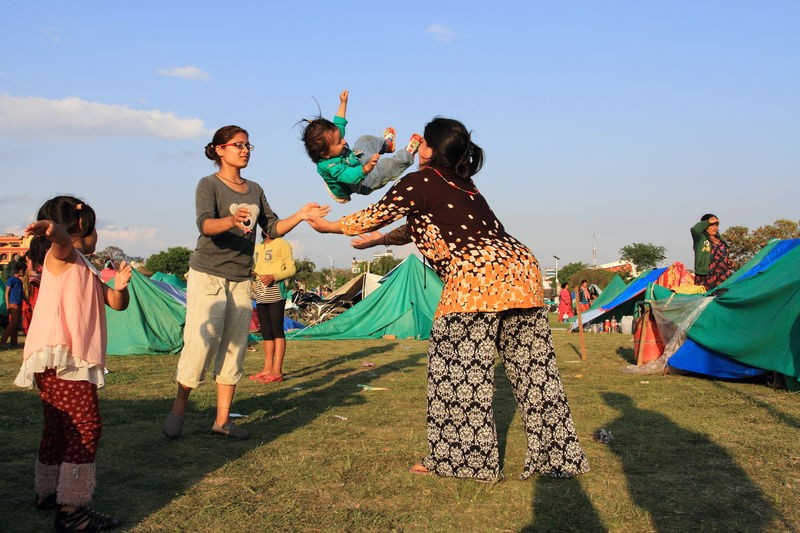
Slowly things are coming back to normal after the devastating earthquake of Saturday but still thousands of people taking shelter at open spaces due to the fear of aftershocks. Image by Ajaya Manandhar. Copyright Demotix (27/4/2015)
Images of broken buildings, collapsed temples, and spilled bricks have blanketed the airwaves for days now. The world is witnessing the aftermath of a 7.9-magnitude earthquake that hit Nepal on Saturday, April 25, and killed thousands of people, with more dying still. Humanitarian relief has flooded the country, but what might be described as an “avalanche of aid” has failed to reach many in remote places, where it's needed desperately.
The full scale of the #NepalEarthquake became apparent Sunday when helicopters found villages completely flattened http://t.co/ZlU1LCF0G0
— Nepali Times (@nepalitimes) April 27, 2015
This will be a lot worse if we don't focus on this NOW. Already late. https://t.co/BPxxf0HgLN
— Prashant Jha (@prashantktm) April 27, 2015
Tragedy of rural Nepal in time of crisis – lack of able-bodied youth to be part of rescue, aways on job migration to India, Gulf, Malaysia.
— Kanak Mani Dixit (@KanakManiDixit) April 28, 2015
People are gradually realizing another disheartening result of the earthquake: the Nepali government is completely overwhelmed.
Also read: #NepalQuake: A Tale of Personal and National Tragedy
Journalists on the ground have expressed their frustration with the situation:
Where are the local authorities? Where is the government? Everyone's asking the same question. #Nepalearthquake @AJENews @AJEnglish
— Subina Shrestha (@ShresthaSubina) April 28, 2015
The Indian helicopters are a resource, but they are not being used. Where is the bottleneck, Ministers of Govt of Nepal get into the act!
— Kanak Mani Dixit (@KanakManiDixit) April 28, 2015
Jan Egeland is the Secretary General of the Norwegian Refugee Council (NRC), an independent, humanitarian, non-profit, non-governmental organisation with expertise in assistance and protection of internally displaced persons in times of crisis. The NRC was present in Haiti in 2010, as well as in the aftermath of Typhoon Hayyan in the Philippines. The group currently have two experts on the ground in Nepal with more on the way.
Egeland highlights the absence of Nepali state officials in relief work by praising all the non-governmental organisations for their work:
Nepalese civil society is by far the biggest responder in #NepalEarthquake, but once again largely ignored by international media.
— Jan Egeland (@NRC_Egeland) April 27, 2015
To the many far from the disaster zone, eyes glued to a mobile device or computer, praying and waiting for news about the safety of their loved ones, anxiety has become chronic. With tensions running high, the government's apparent incapacity has spurred groups and individuals to act independently.
Also read: Social Media Becomes a Lifeline in the Nepal Earthquake Aftermath
Abroad people have gathered together to pray and show support.
In India, Nepalese students held a vigil under the banner #PrayforNepal:
Nepalese students in India hold #PrayforNepal vigil: “We all are in sorrow” http://t.co/aheeJYTQVl pic.twitter.com/0nA3qlne4j
— CNN iReport (@cnnireport) April 27, 2015
In New York City, Prabal Gurung, a highly celebrated Fashion Designer originally from Nepal, organised a fund raiser where he managed to raise $120,000.
In France, under the aegis of the Nepali embassy, many will gather in Paris at the famous Trocadero Plaza overlooking the Eiffel Tower on Saturday May 2 to raise funds that will support either the immediate needs of Nepal's relief efforts or the country's future needs, when international groups leave for other projects. (For more information, please see #SolidariteNepal.)
Yet, while Nepal is still struggling to grasp the quake's impact, people on the ground are now pushing a new narrative of “getting back to normal,” trying to broaden the media's focus beyond stories of loss.
As dust clears, thru binocs from hilltop south of Valley I estimate 80 percent of buildings intact.
— Kunda Dixit (@kundadixit) April 25, 2015
Everyone can do with Kindness at trying times. A young girl feeds her #dog food to street dogs around Boudha. pic.twitter.com/rJfs39Essx
— Kashish Das Shrestha (@kashishds) April 27, 2015
Ratnakar Mahabir. In Patan seems newar comm doing what they do best communally for gens. Little state relief presence pic.twitter.com/SjGHIfWGuS
— Kashish Das Shrestha (@kashishds) April 27, 2015
Yoshadhara Mahabir, Patan – ppl drying traditional sukul after last nite's rain.Again- old houses down, new still up. pic.twitter.com/bJaFbT40Rz
— Kashish Das Shrestha (@kashishds) April 27, 2015
Photographer Bhushan Shilpakar, a leading member of photo.circle, a well-established platform for photography engaging with social change in Nepal, has also started telling the alternate stories of people taking independent action, capturing the sense of purpose and continuity that motivates many people now doing important work on the ground in Nepal.
On this picture, one comment was:
I think this is old photo I can see temples.
Bhushan Shilpakar's reply was:
this was taken an hour ago, not all temples have fallen apart in the square.
To all those watching from abroad, out of reach, this is a reminder not to forget, that even in the toughest times, not all temples have fallen apart. Like them, in the midst of this emotional and physical storm, our common human spirit can, and must, stand firm.
If you would like 100 percent of your proceeds to reach victims of the earthquake please donate to Relief for Nepal Earthquake Victims, where photo.circle has mobilized a group of deeply dedicated independent volunteers to procure basic essentials in Kathmandu – with plastic tarps on the top of the list- and to distribute these to various locations on the periphery of the valley. All administrative costs are covered, you can follow how your funds are being used and, you will be able to see the positive change you are contributing to, through photographs.







1 comment
great tweets! Its so nice to focus on the positive things as well